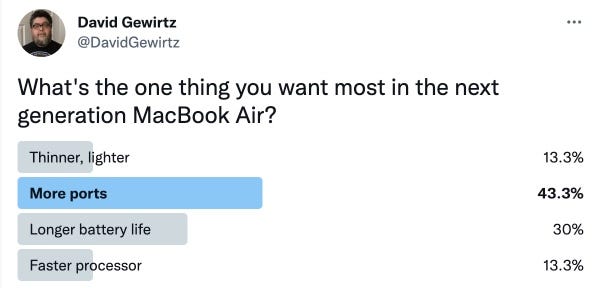The next MacBook Air: What we want vs. what we can expect | ZDNet
When are we getting a new MacBook Air? Our fingers were crossed for an update to the hugely popular machine at Apple’s event earlier this month. But instead of a MacBook Air, there was dead air. And last fall, we got the updated MacBook Pro with beefier M1 Pro and M1 Max processors instead.
Now the rumor mill is predicting a new MacBook Air coming this fall, along with an all-new M2 chip. I’m not sure about that M2 chip (more on that in a bit), but there’s probably something to the idea of a late spring or early fall 2022 update. But what would that mean?
Also: Migrating from Intel iMac to M1 MacBook Air: My five-day journey
What makes a MacBook Air different from a MacBook Pro?
Let’s start with an interesting question: What defines a MacBook Air? Historically, this was a relatively easy question to answer. The MacBook Air was wedge-shaped, with every effort to make it the thinnest and lightest machine, even if that meant removing functional features like ports. The MacBook Pro was the machine that had it all and was often sold in different sizes to truly meet pro-level needs.
But when Apple introduced the M1 MacBook Air and M1 MacBook Pro, they were nearly identical. The only difference was the squared look of the MacBook Pro vs. the wedge shape of the MacBook Air. The base MacBook Pro even had the same two ports as the MacBook Air (although a slightly more expensive model added another two ports). As for weight, they differed by only 3.2 ounces — less than the weight of an Apple Magic Mouse.
Now that Apple has expanded the MacBook Pro offerings — adding the 14- and 16-inch models to the original 13-inch model –there are more tangible differences. I’d go so far as to postulate that since the 13-inch M1 MacBook Pro is so similar to the M1 MacBook Air, it was added as a brand-holding placeholder until the M1 Pro and M1 Max chips were manufacturable.
Now that the bigger chips are out, I wonder if we’ll soon see the 13-inch leave the market. In any case, here’s how they differ:
Screen size
Both the 2020 MacBook Air and 13-inch 2020 MacBook Pro have 13.3-inch LED-backlit displays with IPS technology, and 2560-by-1600 native resolution at 227 pixels per inch with support for millions of colors. But things get bigger with the 14- and 16-inch MacBook Pros, adding Liquid Retina XDR display with 3024-by-1964 native resolution and 3456-by-2234 respectively.
Processor
The slightly more expensive MacBook Air has the identical 8-core CPU with 4 performance cores and 4 efficiency cores, 8-core GPU, and 16-core Neural Engine as the 13-inch MacBook Pro. There’s a version of the MacBook Air that winds up costing just about $100 less, that only has a 7-core GPU (probably allowing Apple to use chips that had minor flaws in wafer production). Of course, the addition of the M1 Pro and M1 Max to the 14- and 16-inch MacBook Pro models increase CPU and GPU cores and overall system performance
RAM and storage
Both the M1 MacBook Air and 13-inch M1 MacBook Pro support up to 16GB RAM and 2TB SSD storage. Once again, the addition of the M1 Pro and M1 Max to the MacBook Pro line give them MacBook Pro more capacity, as much as 64GB RAM and 8TB storage.
Weight
As it turns out, the MacBook Air is lighter than the 13-inch MacBook Pro, but only by 3.2 ounces. The 2020 MacBook Air weighs 2.8 pounds and the 13-inch 2020 MacBook Pro weighs 3.0 pounds. Things bulk up for the bigger MacBook Pros. The 14-inch hefts at 3.5 pounds, and the 16-inch is nearly five pounds. That can be noticeable in your carry bag.
Battery life
Apple lists the MacBook Air as having up to 15 hours of wireless web usage, but the 13-inch MacBook Pro gets 17. So there’s a little more pro in the Pro when it comes to battery. Maybe that’s where the extra 3.2 ounces comes from. Surprisingly enough, the 14-inch specs only 11 hours of wireless web usage and the 16-inch only 14 hours. All that extra processing power and screen snazziness appear to have an impact.
Ports
The MacBook Air only has two Thunderbolt 3 ports (and a headphone jack). You even need to use one of those Thunderbolt ports to provide power. But the 2020 MacBook Pro has, oh… that’s disappointing. The less expensive 2020 MacBook Pro also has just two Thunderbolt 3 ports (and a headphone jack). That said, you could spend a few hundred bucks more and get a 2020 MacBook Pro with four Thunderbolt ports. To be fair, in 2021, Apple finally listened to Every Single MacBook Pro User Ever and added a bunch of necessary ports to the 14- and 16-inch MacBook Pros.
There is one thing that is iconic about the MacBook Air. It has that wedge shape that initially wowed everyone when Steve Jobs pulled it out of a manila envelope all the way back in 2008. That wedge still exists.
So what makes a MacBook Air different from a MacBook Pro. Well, with the MacBook Pro, Apple adds in everything anyone would need to get work done, sacrificing lightness and even battery life. But with the MacBook Air, Apple removes everything it possibly can to get it down to the minimal functionality necessary and make it as light and thin as possible.
What do I want?
I’ve been thinking a lot about what I want from the next MacBook Air, and so have a lot of you. I’ll share my wishlist first, and then, since I also reached out to the Greater Internet, I have some feedback from other users as well.
Also: Migrating to M1 Macs: How I’m upgrading my small fleet of older Apple desktops and laptops
I probably use my 2020 MacBook Air more than any other computer. Yes, I have a powerful, external GPU-equipped Intel Mac mini on my desk for big production projects, a great Windows 11 laptop, and a bunch of Linux servers. But every day I sit on the couch (often with my pup on my lap) and write or code on my little MacBook Air.
I mostly maxed out my machine. It has 16GB RAM, the full 8-core GPU, and 1TB of internal flash storage. The internal storage is so epically fast that it was worth the extra $200 to include it. I often keep the machine on a side shelf, connected to a CalDigit TS3 Plus dock that accepts Ethernet and my HDMI monitor.
There’s a lot to like about this machine. Even doing development, I haven’t run into much in the way of processor performance issues. That said, I find the 16GB RAM maximum to be an impediment, and I’d gladly move to more RAM. I’d love to have this with 32GB or 64GB of RAM.
Also: How much does it cost to own a small fleet of Macs? Total cost of ownership explained
I’d also like a bigger display. I bought this before the 14- and 16-inch M1 Pro and M1 Max MacBook Pros were released. I most often use my MacBook Air with an external monitor on an Ergotron arm. That way, I can type with a separate keyboard while sitting on the couch.
Don’t mock. It’s all about having the warm dog lap. Trust me; that little fuzzball makes life worth living.

The fuzzball in question.
Image: David Gerwitz
In any case, I use the MacBook Air’s display as a second display, and it’s a little tiny for my tastes. There are rumors of larger MacBook Air displays, and I’d like one — although that starts to defeat the “thin and light” ethos that defines the Air.
Beyond those things, around 18 months into ownership, I’m surprisingly satisfied with the machine. The only thing I miss is the ability to play Steam games — Cities Skylines in particular. That game runs on the M1 MacBook Air, but not in a way that makes it actually usable. Of course, that’s more a consequence of moving away from Intel gaming than it is a side effect of the MacBook Air’s thin and light design, but it’s something I do miss.
What do you want?
But I’m just one guy. What do you want? To find out, I did a highly unscientific Twitter poll. I presented four choices (only because Twitter limits you to four choices).

It’s interesting that the DNA of the MacBook Air is stripped-down sleekness, yet most folks want more ports. I think that sleek vs. functionality conflict, which really defines the difference between the MacBook Air and MacBook Pro, is also something users struggle with in terms of what they want most.
I think J LA’s tweet best sums up the collective feeling about ports:

What to expect
Looking back at the introduction of the 14- and 16-inch MacBook Pro models, along with the recent introduction of the Mac Studio, we can make some reasonable predictions about a new MacBook Air.
Release date
Of the 20 MacBook Air models released since January 2008, most were released in the spring and summer. Only twice (in 2019 and again in 2020) did we see fall releases. Releases have also tended to be yearly (or even more rapidly). This is one of the longest waits we’ve had since the model came out.
I’d say, then, that there’s a good chance we’ll see a new MacBook Air announced at WWDC in June, or possibly a drop in July. Worst case, expect October.
Screen
It’s likely that the screen will be upgraded with the smaller bezels and the notch now found in the new MacBook Pro machines. There’s also a chance the screen could jump from 13-inch to 14-inch, but I have my doubts about a 15-inch or 16-inch display.
Originally, the Air was a premium machine, but it’s now become Apple’s entry-level laptop. As such, it’s not clear whether Apple will jump from the 2560-by-1600 Retina display on the current Air to the 3024-by-1964 Liquid Retina XDR display on the MacBook Pro.
Webcam
In today’s Zoom-centric world, the MacBook Air’s miserable 720p webcam is laughable. I’d be shocked if Apple didn’t upgrade the webcam to at least 1080p. Whether it also supports Center Stage is more of a guess, but I’d think it would, since the processor can certainly handle it.
SoC (system on a chip)
Speaking of processor, rumors are that the new MacBook Air will be released with the still-mythical M2 chip. It’s possible, sure, especially since Apple has been squeezing a lot from its initial M1 architecture.
When a chip architecture revs, its usually for a variety of reasons. Parts might be smaller, especially if the wafer making process goes to a smaller scale. Smaller parts often lead to faster parts, because data moves more quickly across shorter distances. Smaller parts also lead to less power consumption. But new chips are often hard to make reliably, at least initially. So I’d think that unless (a) the yields for M2s are great, and (b) the power savings is also great, that Apple will save the initial M2s for something like a new Mac Pro.
I’d think it much more likely that a new MacBook Air will ship with the option for M1 Pro and M1 Max chips, as long as the cooling is doable. Those chips provide access to more RAM, more ports, and more storage. So expect a few more Thunderbolt ports, at least.
Battery life
Apple always likes to make battery life a little better. So I’m betting we’ll see a small yet highlighted increase in MacBook Air battery life — even if it’s just due to a software tweak.
Colors
The MacBook Air offers more colors than the MacBook Pro models, adding a gold tone to its list. And yet, Apple has a gorgeous color palette on its lower-end 24-inch iMac. While Apple’s laptops have generally been very staid in terms of colors, the company did bust a move back in the day, offering clamshell portable Macs in Apple classic colors.
So, with a low (but greater than zero) probability, the new MacBook Air might come in iMac colors.
Wedge shape
Rumors seem to indicate Apple may abandon the iconic wedge shape for new MacBook Air models, but I’d be both surprised and disappointed. That wedge is key to the Air’s design vocabulary. The company even has a patent for it.
Apple may well remove the wedge, if they have an all-over thinner computer, but that would still be unfortunate.
Stay tuned
We’ll be keeping an eye on the MacBook Air. It’s definitely time to see a new model release.
What do you think? Do you own a MacBook Air? Would you upgrade if one came out? What’s the one killer feature that would entice you to upgrade? Let us know in the comments below.
You can follow my day-to-day project updates on social media. Be sure to follow me on Twitter at @DavidGewirtz, on Facebook at Facebook.com/DavidGewirtz, on Instagram at Instagram.com/DavidGewirtz, and on YouTube at YouTube.com/DavidGewirtzTV.
For all the latest Technology News Click Here
For the latest news and updates, follow us on Google News.
